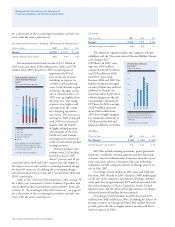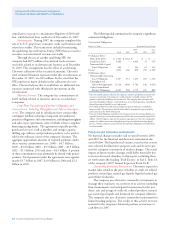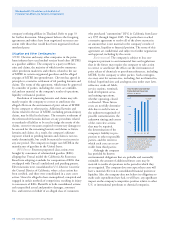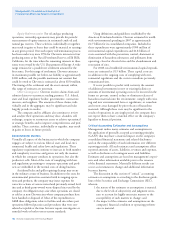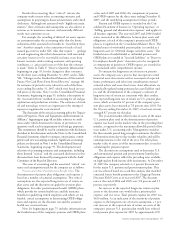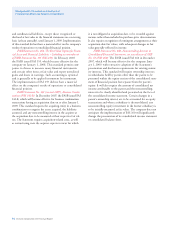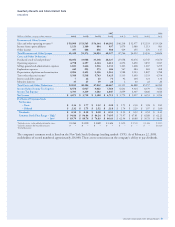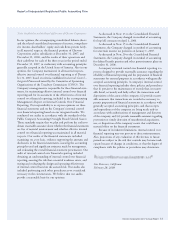Chevron 2007 Annual Report Download - page 48
Download and view the complete annual report
Please find page 48 of the 2007 Chevron annual report below. You can navigate through the pages in the report by either clicking on the pages listed below, or by using the keyword search tool below to find specific information within the annual report.
Management’s Discussion and Analysis of
Financial Condition and Results of Operations
46
Equity Redetermination For oil and gas producing
operations, ownership agreements may provide for periodic
reassessments of equity interests in estimated crude oil and
natural gas reserves. These activities, individually or together,
may result in gains or losses that could be material to earnings
in any given period. One such equity redetermination process
has been under way since 1996 for Chevron’s interests in four
producing zones at the Naval Petroleum Reserve at Elk Hills,
California, for the time when the remaining interests in these
zones were owned by the U.S. Department of Energy. A wide
range remains for a possible net settlement amount for the
four zones. For this range of settlement, Chevron estimates
its maximum possible net before-tax liability at approximately
$200 million, and the possible maximum net amount that
could be owed to Chevron is estimated at about $150 million.
The timing of the settlement and the exact amount within
this range of estimates are uncertain.
Other Contingencies Chevron receives claims from and
submits claims to customers; trading partners; U.S. federal,
state and local regulatory bodies; governments; contractors;
insurers; and suppliers. The amounts of these claims, indi-
vidually and in the aggregate, may be significant and take
lengthy periods to resolve.
The company and its affiliates also continue to review
and analyze their operations and may close, abandon, sell,
exchange, acquire or restructure assets to achieve operational
or strategic benefits and to improve competitiveness and prof-
itability. These activities, individually or together, may result
in gains or losses in future periods.
Virtually all aspects of the businesses in which the company
engages are subject to various federal, state and local envi-
ronmental, health and safety laws and regulations. These
regulatory requirements continue to increase in both number
and complexity over time and govern not only the manner
in which the company conducts its operations, but also the
products it sells. Most of the costs of complying with laws
and regulations pertaining to company operations and prod-
ucts are embedded in the normal costs of doing business.
Accidental leaks and spills requiring cleanup may occur
in the ordinary course of business. In addition to the costs for
environmental protection associated with its ongoing opera-
tions and products, the company may incur expenses for
corrective actions at various owned and previously owned facil-
ities and at third-party-owned waste-disposal sites used by the
company. An obligation may arise when operations are closed
or sold or at non-Chevron sites where company products have
been handled or disposed of. Most of the expenditures to
fulfill these obligations relate to facilities and sites where past
operations followed practices and procedures that were con-
sidered acceptable at the time but now require investigative or
remedial work or both to meet current standards.
Using definitions and guidelines established by the
American Petroleum Institute, Chevron estimated its world-
wide environmental spending in 2007 at approximately
$2.7 billion for its consolidated companies. Included in
these expenditures were approximately $900 million of
environmental capital expenditures and $1.8 billion of
costs associated with the prevention, control, abatement or
elimination of hazardous substances and pollutants from
operating, closed or divested sites and the abandonment and
restoration of sites.
For 2008, total worldwide environmental capital expendi-
tures are estimated at $1.9 billion. These capital costs are
in addition to the ongoing costs of complying with envi-
ronmental regulations and the costs to remediate previously
contaminated sites.
It is not possible to predict with certainty the amount
of additional investments in new or existing facilities or
amounts of incremental operating costs to be incurred in the
future to: prevent, control, reduce or eliminate releases of
hazardous materials into the environment; comply with exist-
ing and new environmental laws or regulations; or remediate
and restore areas damaged by prior releases of hazardous
materials. Although these costs may be significant to the
results of operations in any single period, the company does
not expect them to have a material effect on the company’s
liquidity or financial position.
Management makes many estimates and assumptions in
the application of generally accepted accounting principles
(GAAP) that may have a material impact on the company’s
consolidated financial statements and related disclosures
and on the comparability of such information over different
reporting periods. All such estimates and assumptions affect
reported amounts of assets, liabilities, revenues and expenses,
as well as disclosures of contingent assets and liabilities.
Estimates and assumptions are based on management’s experi-
ence and other information available prior to the issuance
of the financial statements. Materially different results can
occur as circumstances change and additional information
becomes known.
The discussion in this section of “critical” accounting
estimates or assumptions is according to the disclosure guide-
lines of the Securities and Exchange Commission (SEC),
wherein:
1. the nature of the estimates or assumptions is material
due to the levels of subjectivity and judgment neces-
sary to account for highly uncertain matters or the
susceptibility of such matters to change; and
2. the impact of the estimates and assumptions on the
company’s financial condition or operating perform-
ance is material.


